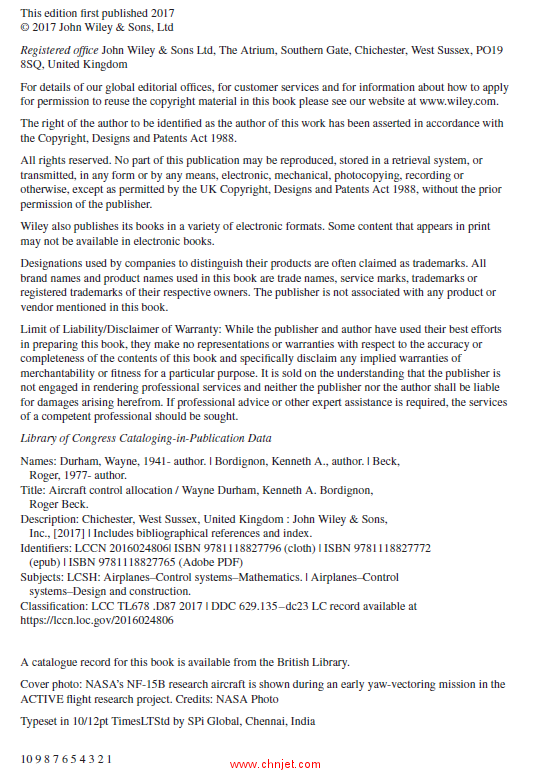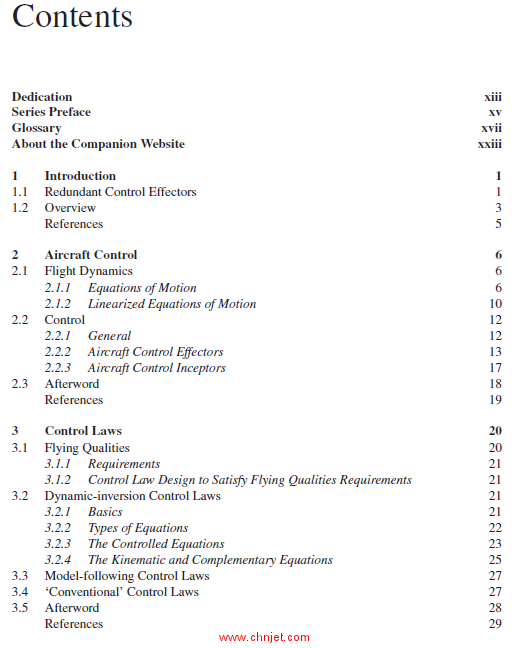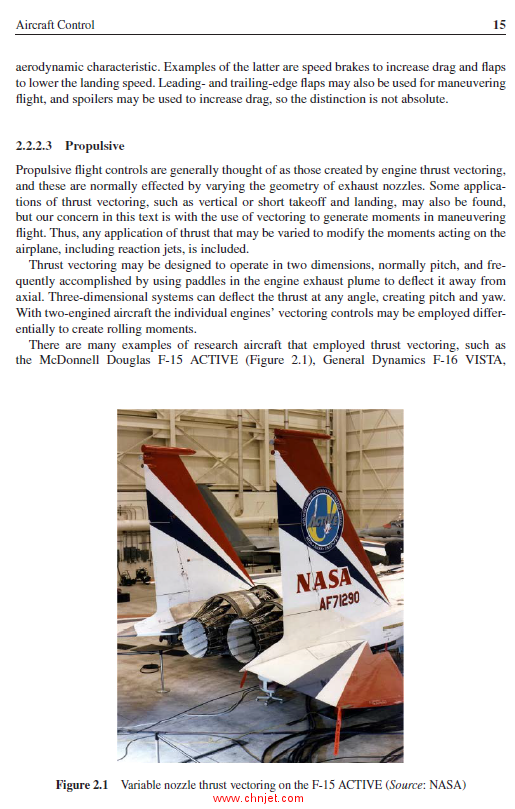马上注册,结交更多好友,享用更多功能,让你轻松玩转社区。
您需要 登录 才可以下载或查看,没有账号?立即注册

×
《Aircraft Control Allocation》
飞机的控制分配
作者:
Wayne Durham
Virginia Polytechnic Institute and State University, USA
Kenneth A. Bordignon
Embry-Riddle Aeronautical University, USA
Roger Beck
Dynamic Concepts, Inc., USA
出版社:Wiley
出版时间:2017年
《Aircraft Control Allocation》

《Aircraft Control Allocation》

《Aircraft Control Allocation》

《Aircraft Control Allocation》

目录
1 Introduction 1
1.1 Redundant Control Effectors 1
1.2 Overview 3
References 5
2 Aircraft Control 6
2.1 Flight Dynamics 6
2.1.1 Equations of Motion 6
2.1.2 Linearized Equations of Motion 10
2.2 Control 12
2.2.1 General 12
2.2.2 Aircraft Control Effectors 13
2.2.3 Aircraft Control Inceptors 17
2.3 Afterword 18
References 19
3 Control Laws 20
3.1 Flying Qualities 20
3.1.1 Requirements 21
3.1.2 Control Law Design to Satisfy Flying Qualities Requirements 21
3.2 Dynamic-inversion Control Laws 21
3.2.1 Basics 21
3.2.2 Types of Equations 22
3.2.3 The Controlled Equations 23
3.2.4 The Kinematic and Complementary Equations 25
3.3 Model-following Control Laws 27
3.4 ‘Conventional’ Control Laws 27
3.5 Afterword 28
References 29
viii Contents
4 The Problem 30
4.1 Control Effectiveness 30
4.2 Constraints 31
4.3 Control Allocation 31
4.3.1 The Control Allocation Problem 32
4.4 Afterword 32
References 33
5 The Geometry of Control Allocation 34
5.1 Admissible Controls 34
5.1.1 General 34
5.1.2 Objects 34
5.1.3 Intersection and Union 37
5.1.4 Convex Hull 39
5.2 Attainable Moments 39
5.3 The Two-moment Problem 43
5.3.1 Area Calculations 48
5.4 The Three-moment Problem 49
5.4.1 Determination of Φ3 49
5.4.2 Volume Calculations 56
5.5 Significance of the Maximum Set 58
5.5.1 As a Standard of Comparison of Different Methods 59
5.5.2 Maneuver Requirements 60
5.5.3 Control Failure Reconfiguration 62
5.6 Afterword 62
References 64
6 Solutions 65
6.1 On-line vs. Off-line Solutions 65
6.1.1 On-line Solutions 65
6.1.2 Off-line Solutions 65
6.2 Optimal vs. Non-optimal Solutions 66
6.2.1 Maximum Capabilities 66
6.2.2 Maximum Volume 66
6.2.3 Nearest to Preferred 66
6.2.4 Unattainable Moments 67
6.3 Preferred Solutions 68
6.4 Ganging 68
6.5 Generalized Inverses 70
6.5.1 The General Case, and the Significance of P2 70
6.5.2 Tailored Generalized Inverses 73
6.5.3 ‘Best’ Generalized Inverse 74
6.5.4 Pseudo-inverses 75
6.5.5 Methods that Incorporate Generalized Inverses 77
6.6 Direct Allocation 80
6.6.1 The Direct Method for the Two-moment Problem 81
6.6.2 The Direct Method for the Three-moment Problem 82
Contents ix
6.7 Edge and Facet Searching 84
6.7.1 Two-dimensional Edge Searching 85
6.7.2 Three-dimensional Facet Searching 88
6.8 Banks’ Method 90
6.8.1 Finding the Original Three Vertices 92
6.8.2 Determining a New Vertex 93
6.8.3 Replacing an Old Vertex 93
6.8.4 Terminating the Algorithm 95
6.9 Linear Programming 95
6.9.1 Casting Control Allocation as a Linear Program 96
6.9.2 Simplex 99
6.10 Moments Attainable by Various Solution Methods 100
6.10.1 General Case (Three-moment Problem) 101
6.10.2 Generalized Inverses (Two- and Three-moment Problems) 102
6.11 Examples 111
6.11.1 Generalized Inverses 111
6.11.2 Direct Allocation 119
6.11.3 Edge and Facet Searching 122
6.11.4 Banks’ Method 128
6.11.5 Linear Programming 132
6.11.6 Convex-hull Volume Calculations 134
6.12 Afterword 137
References 137
7 Frame-wise Control Allocation 139
7.1 General 139
7.2 Path Dependency 141
7.2.1 Examples of Path Dependency 142
7.3 Global vs. Local Control Effectiveness 147
7.4 Restoring 149
7.4.1 The Augmented B matrix 150
7.4.2 Implementation 152
7.4.3 Chattering 153
7.4.4 Minimum-norm Restoring 154
8 Control Allocation and Flight Control System Design 161
8.1 Dynamic-inversion Desired Accelerations 161
8.1.1 The Desired Acceleration: ̇ xdes 161
8.1.2 Command and Regulator Examples 163
8.2 The Maximum Set and Control Law Design 168
8.2.1 In the Design Process 168
8.2.2 In a Mature Design 172
8.2.3 Non-optimal Example 174
References 177
9 Applications 178
9.1 Lessons Learned from the Design of the X-35 Flight Control System 178
9.1.1 Theory vs. Practice 178
x Contents
9.2 Uses of Redundancy 179
9.2.1 Preferred Solutions 179
9.2.2 Resolving Path-dependency Issues 180
9.3 Design Constraints 180
9.3.1 Axis Prioritization 180
9.3.2 Structural Loads 182
9.3.3 Effector Bandwidth 183
9.3.4 Gain Limiting and Stability Margins 184
9.4 Failure Accommodation 184
References 185
A Linear Programming 186
A.1 Control Allocation as a Linear Program 187
A.1.1 Optimality for Attainable Commands 188
A.1.2 Optimality for Unattainable Commands 188
A.2 Standard Forms for Linear Programming Problems 193
A.2.1 Dealing with Negative Unknowns 194
A.2.2 Dealing with Inequality Constraints 195
A.2.3 Writing a Program for Control Allocation in Standard Form 197
A.2.4 Revised Standard Form with Upper Bound 199
A.3 Properties of Linear Program Solutions 201
A.3.1 Basic Solutions 202
A.3.2 Degenerate Basic Solutions 203
A.3.3 Basic Feasible Solutions 204
A.4 Allocating Feasible Commands 204
A.4.1 Minimizing Error to a Preferred Solution 205
A.4.2 Minimizing Maximum Errors 209
A.4.3 Optimizing Linear Secondary Objectives 212
A.5 Building a Control Allocator for Feasible and Infeasible Solutions 213
A.5.1 Dual Branch 214
A.5.2 Single-branch or Mixed Optimization 215
A.5.3 Reduced Program Size without Secondary Optimization 218
A.6 Solvers 219
A.6.1 Preprocessing 220
A.6.2 Solution Algorithms 221
A.6.3 Simplex Method 222
A.6.4 Initialization of the Simplex Algorithm 232
A.7 Afterword 234
References 235
B Flight Simulation 237
B.1 Introduction 237
B.2 Modifications 237
B.2.1 Three of the top-level blocks have been left almost completely unaltered 237
B.2.2 Minor modifications consist of the new Pilot and Sensors blocks 238
Contents xi
B.3 NDI_CLAW 238
B.3.1 NDI_CLAW/Rate Transition 238
B.3.2 NDI_CLAW/PILOT_Mod 238
B.3.3 NDI_CLAW/INPUT 239
B.3.4 NDI_CLAW/MissionManager 239
B.3.5 NDI_CLAW/DynamicInversionControl 240
References 246
C Annotated Bibliography 247
References 247
Index 277
专业书籍
下载地址:(回复后可见)
| ![]()